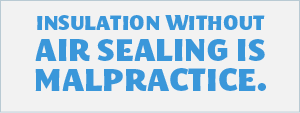Tell Me Again, What Is Air Sealing?
 Air sealing. Two simple words. How can such a simple phrase cause so much head scratching? Most homeowners in the St. Louis area know what insulation is. They are familiar with the fact that things like insulation and windows and furnaces and air conditioners play roles in the comfort and energy efficiency of their homes. But for many people, air sealing is a new and unfamiliar term.
Air sealing. Two simple words. How can such a simple phrase cause so much head scratching? Most homeowners in the St. Louis area know what insulation is. They are familiar with the fact that things like insulation and windows and furnaces and air conditioners play roles in the comfort and energy efficiency of their homes. But for many people, air sealing is a new and unfamiliar term.
Defining Air Sealing
Air sealing may be a new concept but, for many homes, it is the highest priority home improvement you can make. As compared to other improvements, air sealing often makes the biggest impact in terms of keeping all portions of your home warm in winter, all portions cool and comfortable in summer, and reducing your bills for electricity and gas.
What is air sealing? A good definition is: reducing or eliminating excess ventilation. Every home needs ventilation. That means fresh air in and stale air out. The problem is that too much ventilation is a waste of energy. As air moves in and out of your home, you spend money to condition that air. In other words, you spend money to heat the air in winter, and you spend money to cool the air and remove humidity in summer. The more air that moves in and out, the more you spend.
How Much Ventilation Could a Home Need?
The amount of ventilation your home needs is called the Building Airflow Standard (BAS). The BAS is calculated for each home based on the size of the home and the number of occupants. It represents the amount of fresh air in and stale air out your home needs for health and safety. A simple way to look at it is the air inside your home should be completely exchanged with outside air about once every three hours. So in the winter, for example, your furnace needs to completely re-heat all the air in your home once every three hours.
Obviously, if your home has excess ventilation, above the BAS, you are wasting a lot of money heating and cooling more air than is necessary. How do you stop excess ventilation? How do you reduce the amount of air that leaks in and out of your home? Air sealing.
Air Seal Those Leaks!
We accomplish air sealing by finding the largest leaks and closing them. The most important leaks are usually found in the attic. The second most important leaks are in the basement or crawlspace. Leaks in the middle of the house such as around windows and doors are usually the least important. We seal holes, cracks and seams with a variety of materials to include two-part spray foam, one-past spray foam, rigid foam board, plywood, drywall, sheet metal, caulk, high-temperature caulk, and others.
How do you know whether your home could benefit from air sealing? Have an energy audit and find out. If your home needs air sealing, it might be the best home improvement you ever made. Contact us today to schedule your free air sealing estimate!

